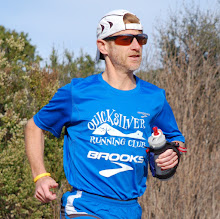Thus starts Christopher McDougall, to share with us the secret he learned from the Tarahumara, in his article published in Men's Health magazine: The Men Who Live Forever. A 7-page introduction to a much deeper dive into this amazing tribe's history and running passion with this 287-page book, published earlier this year (2009): Born To Run - A Hidden Tribe, Super Athletes, and the Greatest Race the World Has Never Seen.
 I learnt about the book thanks to a fortuit email from Mike Palmer, an East Bay ultrarunner, email which I found on my BlackBerry at the San Francisco airport, right after flying back from Paris in May. Mike was announcing a book signing session at the Zombie Runner store in Palo Alto. Agnès was picking me at the airport and we stopped by Palo Alto on our way back. Here is what Chris wrote in my copy of the book:
I learnt about the book thanks to a fortuit email from Mike Palmer, an East Bay ultrarunner, email which I found on my BlackBerry at the San Francisco airport, right after flying back from Paris in May. Mike was announcing a book signing session at the Zombie Runner store in Palo Alto. Agnès was picking me at the airport and we stopped by Palo Alto on our way back. Here is what Chris wrote in my copy of the book:To Jean,With such a nice dedication, my review may be a little biased, but I can assure you that I have No Financial Interest (NFI as we say on forums) in the book. My only interest is in getting more people to learn about our sport… and this is indeed a fabulous book for that!
A better runner than I’ll ever be.
I love your blog and your approach to running.
Bon(ne) chance
C. McDougall
The book
Let’s start with what it is not. This is not an encyclopedia about the history of ultra running, although it contains the description of a few selected key milestones. This is not exclusively about Christopher’s ultra running experience, unlike Dean Karnazes’ books, although Chris shares some tips about how he re-learned to run. This is not a single story. The book actually contains several intertwined tales:
- First and foremost, the story of a Hidden Tribe, the Tarahumara, so hidden by necessity in the Copper Canyons in Mexico that very little has been written so far about this group of ultra ultra runners;
- The story of Caballo Blanco, a unique and intriguing Tarahumara insider;
- The story of the Leadville 100-mile race and the 1994 edition in particular;
- Stories about the ultra running legends Ann Trason and Scott Jurek;
- The story of rising star Jenn Shelton and unorthodox Ted Barefoot;
- The story of a man, the author, who reconnected with the joy and pleasure of running;
- The story of the modern running shoe, raising many questions about its pretended benefits as opposed to the pros of running barefoot;
- The pre-history of running, with scientific discussions about the origin of our ability to run;
- And more stories and anecdotes about coaching, nutrition, health, training, adventure, Man’s passion for running, and the love and pleasure of running.
 What surprised me the most is that, despite the lack of pictures (except for the one on the cover/jacket), Chris’ descriptions are so illustrative and vivid that it is very easy to visualize and relate to every story he is embarking us on. And another fate in my opinion is that Chris remains very nicely focused in his book on running. As a former war correspondent, I am sure he could have chip in a few of his personal anecdotes but he did not. He could have embarked on a dissertation about politics in Mexico around the urbanization of the Copper Canyons or the terrifying development of drug cartels in that region, but he did not. Born To Run is solely about running. For our pleasure.
What surprised me the most is that, despite the lack of pictures (except for the one on the cover/jacket), Chris’ descriptions are so illustrative and vivid that it is very easy to visualize and relate to every story he is embarking us on. And another fate in my opinion is that Chris remains very nicely focused in his book on running. As a former war correspondent, I am sure he could have chip in a few of his personal anecdotes but he did not. He could have embarked on a dissertation about politics in Mexico around the urbanization of the Copper Canyons or the terrifying development of drug cartels in that region, but he did not. Born To Run is solely about running. For our pleasure. Beyond the captivating stories, which taught me a lot about the history of running and ultra running, here are the three main personal takeaways of this book:
Beyond the captivating stories, which taught me a lot about the history of running and ultra running, here are the three main personal takeaways of this book:- When it comes to footwear: simpler and lighter is better. The whole chapter 25 on the history of running shoes was a revelation for me who started running seriously only ten years ago, especially the fact that, the less support the foot get while running, the more the foot will get back to its original and natural form, developing for instance muscles to strengthen the arch. I’ve never run barefoot but can’t wait to try. I cant’ wait either for the brand new Brooks Green Silence coming out in February 2010, a sort of response to the Nike Free when it comes to lightness.
- A sane diet which, I must admit, I’m not ready to embark on yet but I’m seriously considering, or at least contemplating for now, especially for the healthy properties beyond the running side (less risk of cancer in particular).
- And, last but not least, the most important one and the Tarahumara secret, have fun when running. I actually started re-applying this rule during my last arduous long runs, forcing me to laugh when I found the trail tough, reminding me that I run for fun even when I train hard. This secret also reminded me a quote from Lee Jebian, a veteran ultra runner in the Bay Area: “ultra running is too much fun!”
 To illustrate the broad content covered by Chris in his book, here are some pages or sections I particularly like:
To illustrate the broad content covered by Chris in his book, here are some pages or sections I particularly like:- Page 54: how explorer Rick Fisher and his fiancée, Kitty Williams, discovered the Tarahumara
- Chapters 9 and 10: the history of the mythical Leadville 100 race
- Page 59: the Western States debut and how it connected with Leadville
- Chapter 11: how Ann Trason got into ultra running and remained at the top of it for more than 15 years
- Page 88: pacer stories (“A tough pacer can save your race; a sharp one can save your life.”)
- Page 90: the discovery of the Tarahumara secret at Leadville by Chlouber and Coach Vigil (“[…] when they hit the dirt ramp, they hit it laughing. Everybody else walks that hill. […] SUCH A SENSE of joy!”)
- Page 95: the reference to Emile Zatopek and his supernatural connection with the Tarahumara secret (his love for running and ingenuity with regard to training and pacing)
- Page 114: a saying of the Tarahumara Indians that Scott Jurek uses for inspiration: “When you run on the earth and run with the earth, you can run for ever.”
- Chapter 19: how Scott Jurek debuted in ultra running (it’s worth knowing for any runner who might have struggled in cross-country or on short distances) and how he got in “the greatest race the world has never seen.”
- Page 133: how young, surprising and rising ultra star Jenn Shelton got into the Tarahumara picture (and you need to read until the end to get the full picture!)
- Page 145: a mention of the Cascadia mountains which, I assume, the trail shoe designed by Brooks and Scott Jurek have been named after
- Page 150: how Barefoot Ted got his ticket into the Greatest Race and how he then connected his own experiments to the Tarahumara ones
- Chapter 25: again, the enlightening chapter on running shoes
- Page 175: how Alan Webb turned from a “flat-footed frosh” to the fastest American on the mile, thanks to his coach getting him to train bare foot
- Page 181: a glimpse at Bowerman’s marketing genius, or machine (Nike’s co-founder)
- Page 201: the story of Norwegian sailor Mensen Ernst (what’s cool with ultra is that there is no limit: no matter which limit you can think of in running, there is someone who has or will run further, if not faster. Because we are still relearning how to run and perfecting this natural gift)
- Page 202: Eric Orton as an example of what extraordinary things amazing coaches can get out of people
- Page 203: Eric’s quote which kind of rephrases the title of Chris’ book: “Everyone is built for running.”
- Page 207: Ken Mierke’s quote: “You’ve got enough fat to run to California, so the more you train your body to burn fat instead of sugar, the longer your limited sugar tank is going to last.” (A great advertising quote for VESPA, the all-natural amino acid supplement!)
- Page 208: a healthy diet which not only improves running performance but also decreases the risk of cancer (another piece of the Tarahumara Miracle puzzle)
- Page 211: Dr Ruth’s diet
- Page 213: the summary of the Tarahumara secret applied to Chris’ new life as a runner
- Page 222: a scientific comparison of the length of strides between humans and horses (and you have to read the book to know the answer)
- Page 223: “everyone is built for running” indeed with all the best attributes for running marathons: “Springy legs, twiggy torsos, sweat glands, hairless skin, vertical bodies that retain less sun heat,” and the list could go on
- Page 253: one sentence which summarizes Scott Jurek’s philosophy of running as well as the legendary camaraderie which characterizes ultra running: “The reason we race isn’t much to beat each other, but to be with each other.”
- Page 254: Scott Jurek, “the world’s only twenty-first-century Tarahumara.”
- Page 273: Scott’s quote to struggling Chris: “I’ve been there, man. I’ve been there a lot. It takes more guts than going fast.” So true...
One last note: it is really cool to get to know these super athletes better, from some of their struggles to their better known accomplishments. This is another treat of ultrarunning: these amazing athletes are very approachable and you can even run with them! At least we have that over the sports which get so much coverage in the medias such as basketball, golf, baseball, soccer... Yet, we want more people to know about our sport, an ultra paradox...
 Other relevant links and sources of pictures to complement Chris' vivid text:
Other relevant links and sources of pictures to complement Chris' vivid text:- What Can The Tarahumara Indians Tell Us About The Importance Of Running Long Distances? (Fitness SpotLight)
- Caballo Blanco's home page
- A portrait of Jenn Shelton (Outside.com)
- Chris' original article on the Tarahumara secret in Men's Health magazine: The Men Who Live Forever
- Dietary cholesterol and the plasma lipids and lipoproteins in the Tarahumara Indians: a people habituated to a low cholesterol diet after weaning (pdf)
- The food and nutrient intakes of the Tarahumara Indians of Mexico (pdf)
- The Wikipedia page on the Tarahumaras































.jpg )
